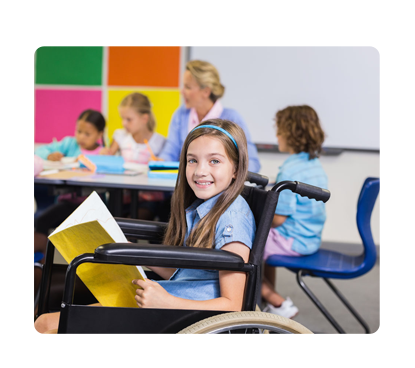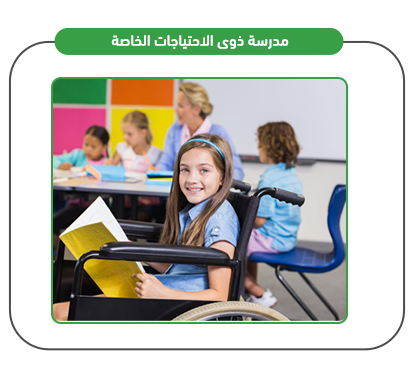The Special Needs School provides an exceptional learning environment focused on meeting the individual needs of each student through innovative educational programs and customized curricula. The school adopts a comprehensive approach that combines both academic and rehabilitative aspects, allowing students to develop their intellectual and social abilities simultaneously. Furthermore, the school offers specialized support through a dedicated team of experienced educators skilled in handling various disabilities. To achieve the best outcomes, the educational activities are designed using modern pedagogical techniques that consider individual differences and work to enhance self-confidence and independence. The school also encourages students to participate in social and sports activities, contributing to their positive integration into society. It is worth noting that through this integrated approach, the school aims to achieve comprehensive educational goals, including the development of life skills and the enhancement of personal competencies, ensuring that each student has the opportunity for academic and social success.

The Special Needs School project aims to establish a specialized school focused on the care and rehabilitation of children with special needs. The school will offer a comprehensive set of services to address both the educational and rehabilitative needs of children who face difficulties in leading normal lives. To achieve this goal, the project will implement the latest scientific and educational methods, incorporating modern technology to provide competitive services that meet the growing demand for such services. Given the importance of investment in social and educational sectors, both in developed and developing countries, the Special Needs School project stands out as a unique opportunity to enhance communities’ capacity to address the special needs of children. Furthermore, the project aims to develop children’s talents and prepare them for effective integration into society. Beyond providing essential services, the project also aims to generate significant investment returns, making it a sustainable model that combines social impact with economic feasibility.<br><br><br>



A tailored educational environment to meet the needs of each student.
Flexible curricula focusing on interactive learning.
A specialized team including teachers and specialists.
Innovative educational technologies to enhance the learning process.
Individualized care for each student to ensure noticeable progress.
Providing diverse teaching strategies that suit the different needs of students.
Natural and functional therapy programs to improve motor skills.
A safe and supportive environment that encourages learning and interaction.
Continuous support for families by offering consultations and guidance.
Focus on enhancing independence and achieving self-reliance.
Organizing training workshops for teachers to develop their skills.
Executive summary
Study project services/products
Market Size Analysis
Risk Assessment
Technical study
Financial study
Organizational and administrative study

The Education Sector in GCC Countries
Because “Mashroo3k” Economic Consulting and Market Research Company believes in the importance of the education sector and its role in localizing national labor, it presents below the key indicators of the educational sector in GCC countries, thereby encouraging investment in this vital sector:
The total number of students in the Early Childhood Development stage (including nurseries and kindergartens) in GCC countries, according to the latest available statistics, reached 851.5 thousand students.
The number of school education students in the GCC was estimated at 9.3 million students (79.4% in the public sector and 20.6% in the private sector).
The number of adult education center learners was estimated at 181,247 students.
The number of higher education students was 2,206,446 students.
The number of early childhood education teachers was 50,647 teachers.
The number of school education teachers was estimated at 727,904 teachers.
There are 5,806 educational institutions operating at the early childhood stage.
There are 32,310 educational institutions operating at the school education stage.
Over the past years, governments in GCC countries have sought to bridge the gap between education and the labor market. They have adopted curricula that increase the share of vocational and technical education and encourage learning through modern media and technologies. It is also worth noting the increase in government spending by these six countries on education and its quality to graduate generations that meet the private sector’s labor needs.
According to the latest statistics:
Saudi Arabia spends 18.9% of its budget on education.
The UAE spends 14.8%.
Oman spends 12.2%.
Bahrain spends 9.8%.
Kuwait spends 12.3%.
Qatar spends 10.5% of its budget on education.
By the year 2023, the value of the private education market in GCC countries is expected to reach $26.2 billion.
The Global Education Sector:
The size of the global educational services market reached approximately $2,882.52 billion by the end of 2021, and global experts expect it to reach $3,191.79 billion by the end of 2022 — achieving a compound annual growth rate (CAGR) of 10.7%.
By 2026, the market value is projected to increase to $4,623.90 billion, achieving a CAGR of 9.7% over the forecast period.

By 2030, the global value of education as an industry is expected to reach $10 trillion USD.
By 2024, the global online education market is projected to reach $247.46 billion USD.
The AI-powered education market is expected to expand at a compound annual growth rate (CAGR) of 36% from 2022 to 2030.
In the year 2000, the number of pupils worldwide was approximately 657 million, and this number increased to 739 million by 2019.
In 2000, the number of secondary education students was around 452 million, rising to 601 million by 2019.